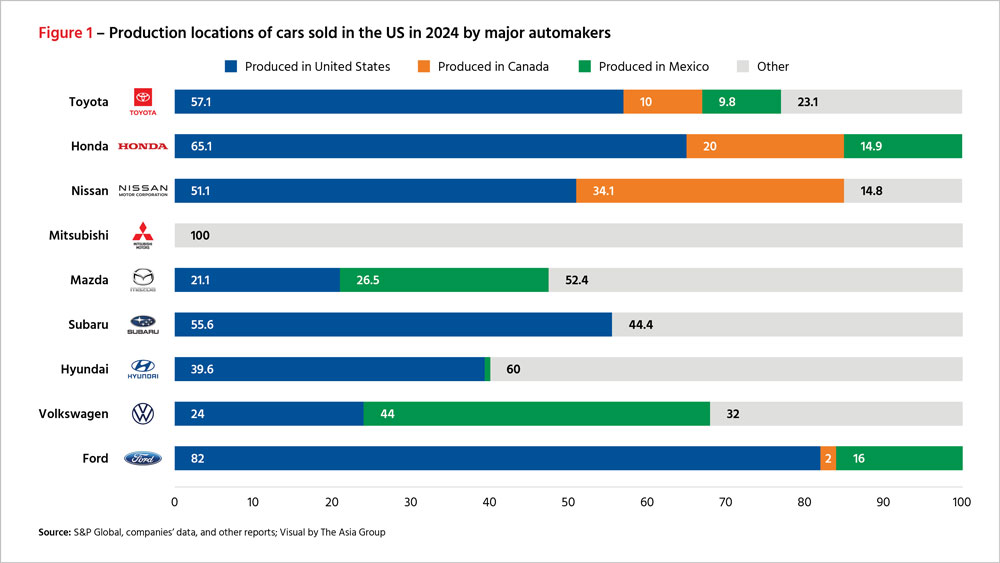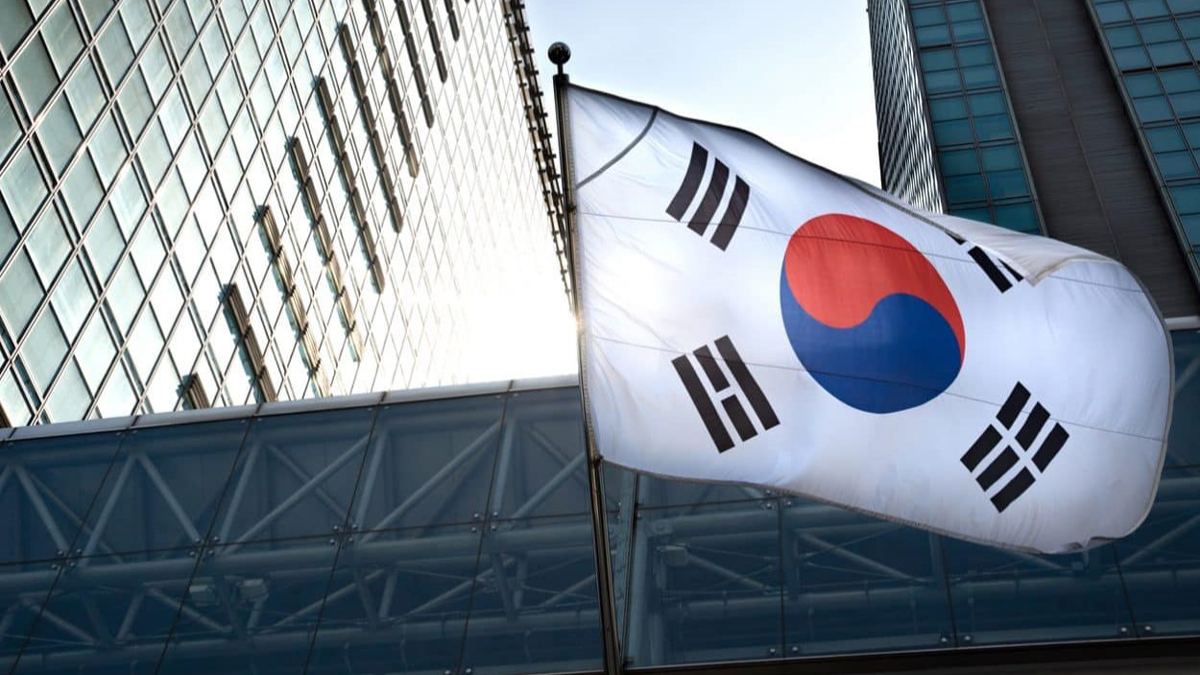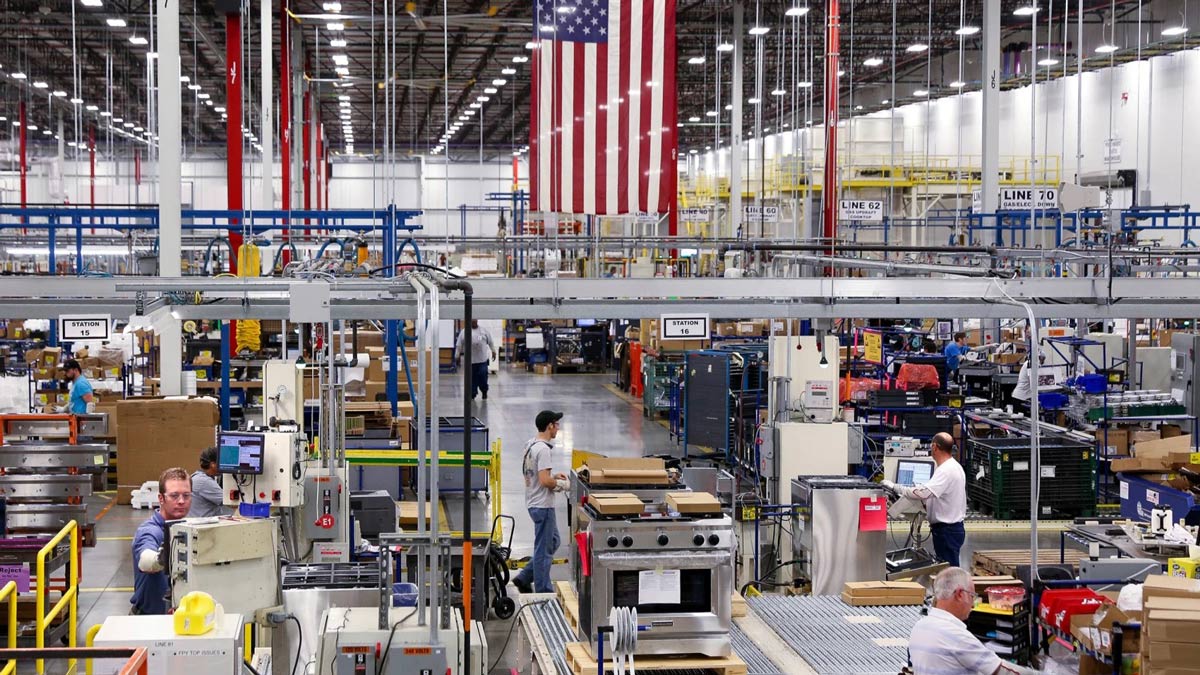Trade distortion and protectionism
Tariffs hit some automakers more than others
Published 22 July 2025
Auto tariffs have become one of the thorniest issues in the Trump administration’s trade negotiations with key partners. It’s not difficult to see why: auto and auto parts accounted for about one-third of Japan's and South Korea's overall exports to the US in 2024, while the share was nearly 20% for Germany. In this special report, The Asia Group examines the sales markets and tariff impact for the world’s major automakers.
To understand why auto tariffs have become one of the thorniest issues in the Trump administration’s trade negotiations with key partners, just look at how much these economies rely on auto exports to the US.
For Japan and South Korea, auto and auto parts accounted for about one-third of their overall exports to the US last year. For Germany, the share was nearly 20%.
A closer look at trade and company data shows the impact of the tariffs vary widely across companies, depending on where they manufacture their vehicles. Some are hit much harder than others and are facing greater uncertainty about their operations and earnings.
Among Japanese automakers, Mazda Motor, Subaru, and Mitsubishi Motors are hit particularly hard because of their heavy reliance on vehicles imported from Japan. In contrast, Honda, Nissan, and Toyota build the majority of their cars in the US, Canada, or Mexico, after years of shifting production closer to American consumers.
South Korean automakers are also feeling the pressure. Hyundai Motor and Kia both import more than half of the cars they sell in the US from factories in Korea. Among German carmakers, Mercedes-Benz imported nearly two out of every three cars from outside of North America.
The impact on these companies – along with their workers, suppliers, and the communities that host their factories – has made reducing the auto tariff a No. 1 goal for officials in their home countries. That has complicated their negotiations with the Trump administration, which sees bolstering domestic auto manufacturing as a high priority.
Japanese Prime Minister Shigeru Ishiba has called the auto tariffs "absolutely unacceptable." Ahn Duk-geun, South Korea’s trade minister until June, vowed to address them "expeditiously," calling it the most important issue for Seoul.
After rounds of negotiations, President Trump informed Japan and South Korea on July 7 that he would impose 25% levies on the two countries unless they can broker new deals before August 1.
Automakers’ responses to Trump tariffs
The Trump administration’s tariffs on automobiles made outside the US took effect on April 3. Passenger car tariffs now total 27.5% of vehicle value - comprising of the existing most-favored-nation (MFN) rate of 2.5% and an additional 25% imposed on national security grounds under Section 232 of the Trade Expansion Act.
For vehicles from Mexico and Canada that do not meet rules of origin (ROO) under the US-Mexico-Canada Agreement (USMCA), an additional 25% tariff under the International Emergency Economic Powers Act (IEEPA) is applied, bringing the combined rate to 52.5%.
Even companies that manufacture more than half of the vehicles they sell in the US locally face billions in lost profit as imported parts are subject to the duties. Toyota said the 25% tariff cost the company roughly US$1.3 billion in April and May alone. Honda, which assembles two in three vehicles it sells in the United States and the rest in Canada and Mexico, is forecasting a 70% drop in net profit for the current fiscal year.
The varying degrees of tariff impact could have significant implications for where the companies eventually choose to make and sell their products. That, in turn, could determine their long-term competitiveness in the global market.
For now, automakers have three options:
1) Adjust production — Honda, Nissan, Volkswagen, and Mercedes plan to relocate production of some vehicles to the US. Mitsubishi, Mazda, Stellantis, and Tesla are limiting their supply volumes to the market. Toyota aims to increase local procurement of components over the long term.
2) Raise prices — Mitsubishi, Subaru, Toyota, BMW, and Ford have already raised prices. Hyundai and Kia may follow suit.
3) Layoffs — Stellantis and Nissan are implementing workforce reductions.
How the tariffs are reshaping EV supply chains
The Trump tariffs are beginning to reshape automakers’ strategies in the electric vehicle sector as well. Here, companies are taking divergent paths too.
After robust growth in recent years, the US EV market now faces huge uncertainty as the Trump administration rolls back the Biden-era push for clean vehicle adoption. It is revising greenhouse gas (GHG) regulations that had called for significant increases in EV sales and seeks to eliminate California’s state rules requiring all new autos sold after 2035 to be zero-emission vehicles (ZEV). In 2024, Americans bought a record 1.3 million EVs, up 7.3% from a year earlier.
The auto tariffs are compounding industry pressures, disrupting an already fragile EV supply chain. Tesla temporarily halted parts imports from China, and Nissan abandoned plans for a new battery plant in Kyushu, Japan.
Amid policy shifts and market uncertainty, automakers are responding in different ways. Toyota and Subaru are ramping up their EV footprint in North America with new models, expanded lineups, and local production plans starting in 2026. Toyota is taking additional steps to appeal to US consumers by refreshing branding, extending driving range, and adjusting charging standards.
Honda, meanwhile, is pulling back. It has trimmed its planned investment from US$68 billion to US$48 billion and delayed major projects, including a new plant in Ontario, Canada. With slower-than-expected EV adoption and policy uncertainty, Honda is focusing more on hybrids and motorcycles to preserve profitability and hedge against EV risks.
Nissan, struggling with declining sale and net losses, is reportedly negotiating with Taiwan’s Foxconn to manufacture EVs at its plant near Tokyo — a drastic step that would mitigate the impact on suppliers and thousands of workers.
To speed up local production of vehicles and components in the US, automakers are increasingly collaborating, setting aside longtime rivalry. Honda plans to source batteries for 400,000 hybrid vehicles from Toyota’s North Carolina battery plant, and Ford is allowing Nissan to use part of its new Kentucky battery plant. These moves suggest a shift toward a new, shared supply chain as companies navigate the uncertain North American EV landscape.
How US tariffs affect world automakers
| Auto company | Global vs US sales (2024) | Origin of US auto sales | Component sourcing sites | Financial impact | Tariff rates |
| JAPANESE AUTOMAKERS | |||||
| Toyota | Global: 10.2 million vehicles sold total
US: 2.3 million vehicles sold |
57.1% produced in the United States
23.1% imported from Japan 10% imported from Canada 9.8% imported from Mexico |
United States
Mexico Canada Asia: Japan, China, India, Thailand Toyota imports about 43% of the parts used in its US vehicle production. |
Toyota expects tariffs could reduce April-May auto profit by JPY 180 billion (USD 1.23 billion) and FY26 net profit by 34.9%
Toyota will maintain its existing operations and focus on bringing down fixed costs. The company also does not plan to raise prices for vehicles sold in the US |
USMCA-compliant auto / auto parts from Canada and Mexico (25%) Non-USMCA-compliant auto / auto parts from Canada and Mexico All other auto (27.5%) |
| Honda | Global: 3.7 million vehicles US: |
65.1% produced in the United States
20% imported from Canada 14.9% imported from Mexico |
United States
Canada Mexico China Honda imports about 39% of the parts used in its US production. Honda plans to build new EV and battery plants in Canada. |
Honda expects tariffs could reduce annual auto profit by JPY 650 billion (USD 4.42 billion) and FY26 net profit by 70%.
Honda is considering relocating production in Mexico to the United States. |
USMCA-compliant auto / auto parts from Canada and Mexico (25%) Non-USMCA-compliant auto / auto parts from Canada and Mexico |
| Nissan | Global: 3.3 million vehicles US: |
51.1% produced in the United States
34.1% imported from Mexico 14.8% imported from Japan |
United States
Mexico Japan China Nissan imports about 58% of the parts used in its US vehicle production. |
Nissan expects tariffs could reduce annual auto profits by JPY 450 billion (USD 3 billion) at maximum. Possible retail price hikes from June 2.
Nissan cut US-bound output in Fukuoka, stop orders for non-USMCA models made in Mexico, and cancelled its plan to reduce production in Tennessee. |
USMCA-compliant auto / auto parts from Mexico (25%) Non-USMCA-compliant auto / auto parts from Mexico All other auto (27.5%) Japan reciprocal (10% until July 31, then 25%) |
| Mitsubishi | Global: 944,708 vehicles US: 109,843 vehicles sold (11.6% of total sales) |
72.9% imported from Japan
27.1% imported from Thailand |
Mitsubishi closed its US factory in 2015. | Mitsubishi expects the tariffs-linked cost increase of JPY50 billion (USD 344 million). Mulling price hikes for vehicles sold in the US
Stopped deliveries of finished cars to its 330 US dealers for now. |
All auto (27.5%) |
| Mazda | Global: 1.2 million vehicles
US: |
21.1% produced in the United States
52.4% imported from Japan 26.5% imported from Mexico |
United States
Mexico Japan China Mazda imports about 46% of the parts used in its US vehicle production. |
NHK reported tariffs could reduce annual auto profit by JPY 312 billion (USD 2.13 billion)
Mazda plans a temporary production halt for Canada-bound SUVs at its US plant to avoid retaliatory tariffs. |
USMCA-compliant auto / auto parts from Mexico (25%) Non-USMCA-compliant auto / auto parts from Mexico All other auto (27.5%) Japan reciprocal (10% until July 31, then 25%) |
| Subaru | Global: 941,758 vehicles
US: 667,725 vehicles sold (70.9% of total sales) |
55.6% produced in the United States
44.4% imported from Japan |
United States
Japan Subaru imports about 52% of the parts used in its US vehicle production. |
Subaru expects tariffs could reduce annual auto profit by USD 2.5 billion.
Price hikes for several models planned. |
All auto (27.5%)
Japan reciprocal (10% until July 31, then 25%) |
| KOREAN AUTOMAKERS | |||||
| Hyundai | Global: 4.1 million vehicles
US: |
39.6% produced in the United States
52.3% imported from Korea 0.4% imported from Mexico |
United States
South Korea China India Japan |
Hyundai warned US dealers that it is evaluating its pricing strategy due to the tariffs, announcing it would raise prices after June 2. | USMCA-compliant auto / auto parts from Mexico (25%) Non-USMCA-compliant auto / auto parts from Mexico All other auto (27.5%) Korea reciprocal (10% until July 31, then 25%) |
| Kia | Global: 3.1 million vehicles sold
US: |
44.4% produced in the United States, with the remainder imported from Korea and Mexico. | South Korea
Mexico China India Japan |
Price increases announced to reflect tariff costs through June 2. | USMCA-compliant auto / auto parts from Mexico (25%) All other auto (27.5%) Non-USMCA-compliant auto / auto parts from Mexico |
| EUROPEAN AUTOMAKERS | |||||
| Volkswagen | Global: 9.0 million vehicles
US: |
24% produced in the United States
44% imported from Mexico The remainder comes mainly from Germany |
United States
Mexico Japan China Germany United Kingdom |
VW plans to add an import fee later this month to the price of imported cars sold in the United States. | USMCA-compliant auto / auto parts from Mexico (25%) Non-USMCA-compliant from Mexico Other auto (27.5%) EU reciprocal (10% until July 31, then 30%) |
| BMW | Global: 2,450,854 vehicles US: 371,346 vehicles (15.1% of total sales) |
65% produced in the United States
The remainder imported from Germany, Great Britain, and Mexico |
United States
Mexico India Germany Netherlands Belgium |
BMW expects tariffs could dent the carmaker's earnings by EUR 1 billion (USD 1.09 billion) this year. | USMCA-compliant from Mexico (25%) Non-USMCA-compliant from Mexico British (10% for up to 100K cars) Other auto (27.5%) |
| Mercedes-Benz | Global: 2.4 million vehicles
US: |
36.5% produced in the United States
The remainder imported from Germany, Hungary, Austria, Finland, South Africa, and Mexico |
United States
Mexico Canada China Germany Belgium Mercedes imports about 90% of the parts used in its US vehicle production. |
Mercedes will add production of its GLC SUV for North America at its plant in Alabama. | All auto (27.5%)
All other auto (27.5%) EU reciprocal (10% until July 31, then 30%) China reciprocal (30% until August 12) |
| AMERICAN AUTOMAKERS | |||||
| General Motors | Global: 4.01 million vehicles
US: |
Roughly 52% of GM vehicles sold in the US during the first three quarters of 2024 were assembled in the United States.
30% assembled in Canada and Mexico, and another 15% from South Korea. |
United States
Canada Mexico South Korea |
GM expects a USD 4 to 5 billion drop in its full-year profit outlook. | USMCA-compliant auto / auto parts from Canada and Mexico (25%) All other auto (27.5%) Non-USMCA-Compliant auto / auto parts from Canada and Mexico |
| Ford | Global: 3.6 million vehicles US: |
80% of vehicles sold in the US are assembled in the United States.
The other 20% are imported from Canada and Mexico, |
United States
Canada Mexico Europe: Germany, Poland, Hungary, Sweden Asia: Japan, China |
Ford expects a USD 1.5 billion hit to full year profits. The tariffs are also expected to add USD 2.5 billion in costs overall for the year, mainly related to expenses from importing vehicles from Mexico and China.
Prices hiked for three of its Mexico-produced models effective May 2. |
USMCA-compliant auto / auto parts from Canada and Mexico (25%) Non-USMCA-compliant auto / auto parts from Canada and Mexico |
| Stellantis | Global: 5.7 million vehicles US
1.3 million vehicles sold |
57% produced in the United States
39% produced in Canada and Mexico |
United States
Canada Mexico France Asia: Japan, China, South Korea |
Stellantis has suspended its full-year financial guidance "due to evolving tariff policies" and the difficulty in predicting possible impacts.
Paused production at its assembly plants in Canada and Mexico and furloughed 900 workers at its US plants; it anticipates further layoffs. |
USMCA-compliant auto / auto parts from Canada and Mexico (25%) Non-USMCA-compliant auto / auto parts from Canada and Mexico |
| Tesla | Global: 1,789,226 vehicles sold total
US 634,000 EVs sold (35.4% of total sales)
|
United States (100%) | 20-25% of components for all Tesla cars were imported, though it did not specify from which countries.
60-75% of components were made in the United States or Canada. |
Tesla cancelled plans to ship components from China for Cybercab and Semi electric trucks, which will disrupt mass production. | Exempt from auto import tariffs. Vehicles with 85% or more domestic content are fully exempt from the tariffs. |
This article is a slightly edited and updated version of a report first published by The Asia Group.
© The Hinrich Foundation. See our website Terms and conditions for our copyright and reprint policy. All statements of fact and the views, conclusions and recommendations expressed in this publication are the sole responsibility of the author(s).









